| Core races | |||
| Allied races | |||
 | |
| Main leader |
King Varian Wrynn (King of Stormwind) King Magni Bronzebeard (Lord of Ironforge) Jaina Proudmoore (Ruler of Theramore, co-leader of the western Alliance)[1] Tyrande Whisperwind (High Priestess of Elune, co-leader of the western Alliance) Prophet Velen (Leader of the draenei) Genn Greymane (Lord of Gilneas) Gelbin Mekkatorque (King of gnomes, High Tinker of Gnomeregan) |
| Secondary leaders |
Archbishop Benedictus (Leader of the Church of the Light) Fandral Staghelm (leader of the Cenarion Circle) Tandred Proudmoore (Lord Admiral of Kul Tiras) Falstad Wildhammer (High Thane of Aerie Peak) Galen Trollbane (Lord of Stromgarde) Vereesa Windrunner (Ranger General of the Silver Covenant) |
| Race(s) |
Template:Broken Draenei Race Template:Draenei Race Template:Frost dwarf Race Template:Gnome Race Template:Half-Elf Race Template:High Elf Race Template:Human Race Template:Ironforge Dwarf Race Template:Night Elf Race Template:Wildhammer Dwarf Race Template:Worgen Race |
| Capital | Stormwind City, Ironforge |
| Other major settlements | Darnassus, Exodar, Theramore, Boralus, Aerie Peak |
| Theater of operations | Eastern Kingdoms, Lordaeron, Northern Kalimdor, Theramore Isle, Azuremyst Isles, Outland, Northrend |
| Language(s) | Common |
The Alliance (aka Grand Alliance[2] or Alliance Forces[citation needed] ) is one of two major political factions of the mortal races in Azeroth, its counterpart being the Horde. The Alliance consists of powerful cultures and groups bound not by desperation or necessity, but by their deep commitments to abstract concepts like nobility and honor[3]. The Alliance was once also known as the Alliance of Lordaeron when its leadership was centered in Lordaeron. However, the Alliance was forced to move the bulk of its forces to Kalimdor and to the southern Azerothian continents of Azeroth and Khaz Modan after a plague of undeath ravaged the Kingdom of Lordaeron several years ago. It has since lost many members, as well as gained new allies.
Major members
The major partners in the Alliance are:
- The

 Humans.
Humans.
- Kingdom of Stormwind: Led by King Varian Wrynn. Formerly led by Anduin Wrynn (with Bolvar Fordragon as regent) in Varian's absence (prior to the war for Northrend).
- Capital is Stormwind City in northwestern Elwynn Forest, in the subcontinent of Azeroth.
- One of the founding members of the Alliance of Lordaeron following Stormwind City's destruction in the First War, restored to prominence after the Second. One of the few human nations not affected in some fashion by the Third War.
- The Kingdom of Stormwind's influence extends into the surrounding lands, including Lakeshire in the Redridge Mountains and Darkshire in Duskwood. A sizable naval fleet enables Stormwind to expand across the seas, with outposts in the Borean Tundra, the Howling Fjord, the Grizzly Hills and the Dragonblight in southern Northrend.
- Theramore: Led by Lady Jaina Proudmoore.
- Capital is Theramore Isle, located in Dustwallow Marsh.
- Founded by refugees fleeing the deprevations of the Scourge. Forces include men from Lordaeron, Stromgarde, Kul Tiras, and Gilneas. Established early peace treaty with the Horde.
- Northwatch Hold in the Barrens is their primary fortification outside of Theramore itself. There are also several fortified watch towers spread throughout Dustwallow Marsh itself.
- Kingdom of Stormwind: Led by King Varian Wrynn. Formerly led by Anduin Wrynn (with Bolvar Fordragon as regent) in Varian's absence (prior to the war for Northrend).
- The

 Dwarves of Khaz Modan.
Dwarves of Khaz Modan.
- Led by King Magni Bronzebeard.
- Capital is Ironforge, located in northern Dun Morogh.
- Pledged to the Alliance following the Bleeding Hollow's invasion of Khaz Modan.
- The Kingdom of Ironforge controls several settlements in Khaz Modan, including Kharanos and Thelsamar. More distant outposts such as Dun Garok and Bael Modan are the result of exploration and service to the Grand Alliance. The Explorers' League also has outposts in Northrend, including at least one base camp in the Storm Peaks and a small outpost in the Howling Fjord.
- Led by King Magni Bronzebeard.
- The

 Gnomes.
Gnomes.
- Led by High Tinker Gelbin Mekkatorque, King of Gnomes.
- Long-time capital was Gnomeregan, located in western Dun Morogh. Temporary settlement is Tinker Town in Ironforge.
- Cousins of the dwarves, joining with their long-time allies to provide technological wonders to aid the Alliance in its fight against its enemies.
- Gnomish outposts can be found in Blade's Edge Mountains in Outland and the Borean Tundra in Northrend.
- Led by High Tinker Gelbin Mekkatorque, King of Gnomes.
- The

 Night Elves of Darnassus.
Night Elves of Darnassus.
- Led by High Priestess Tyrande Whisperwind and Archdruid Fandral Staghelm. General Shandris Feathermoon commands the Sentinel Army.
- Capital is Darnassus, located on the new (failed) World Tree of Teldrassil off the coast of northern Kalimdor.
- Allied with the survivors of Lordaeron and the Horde at the behest of Medivh, which resulted in the defeat of Archimonde at the Battle of Mount Hyjal. Remained with the Alliance following the battle.
- Controls several larger outposts, including Astranaar and Forest Song (jointly with the draenei) in Ashenvale, Feathermoon Stronghold in Feralas, the port of Auberdine in Darkshore, and Sylvanaar in Blade's Edge Mountains.
- Led by High Priestess Tyrande Whisperwind and Archdruid Fandral Staghelm. General Shandris Feathermoon commands the Sentinel Army.
- The

 Draenei of the Exodar.
Draenei of the Exodar.
- Led by the Prophet Velen.
- Long-time capital was Shattrath City on Draenor, now known as Outland. Current capital is the Exodar, located in the western portion of Azuremyst Isle, off the coast of northern Kalimdor.
- Refugees of the eredar race fleeing their corrupted brethren, seeking allies to fight against the Burning Legion. Lived on Draenor until the orcish onslaught, fled from the Legion and the forces of Illidan Stormrage by stealing the Exodar, one of the satellites of Tempest Keep.
- Draenei outposts include Azure Watch on Azuremyst Isle, Blood Watch on Bloodmyst Isle, Forest Song (jointly with the night elves) in Ashenvale, the Harborage in the Swamp of Sorrows, the Temple of Telhamat in Hellfire Peninsula, and Telredor in Zangarmarsh.
- Led by the Prophet Velen.
- The

 Worgen of Gilneas.
Worgen of Gilneas.
- Led by King Genn Greymane.
- Capital is Greymane City in central Gilneas.
- Formerly one of the strongest of the human nations, Gilneas was one of the founding members of the Alliance of Lordaeron, sealing itself off from the world after the Second War to avoid being brought into "other people's conflicts". People and lands transformed by the worgen plague that resulted in civil war engulfing Gilneas. They will officially rejoin the Alliance in World of Warcraft: Cataclysm.
- Only other known settlement is Duskhaven.
- Led by King Genn Greymane.
Alliance Forces
- Alliance Vanguard
- Valiance Expedition
- The Silver Covenant, a militant core of high elves that have united under the banner of Vereesa Windrunner and joined the Alliance forces in Northrend.
- The Frostborn in the Storm Peaks, a lost race of dwarves led by Yorg Stormheart (Muradin Bronzebeard).
- The Explorers' League, led by Brann Bronzebeard, searches for rare artifacts and digs into dwarven history.
Other influential powers are also part of the Grand Alliance:
- The human merchant nation of Kul Tiras, located west of Khaz Modan.
- The survivors of the kingdom of Stromgarde in the Arathi Highlands, located on the site of the original capital of Strom. Led by Prince Galen Trollbane. The kingdom declined rapidly following the Third War, losing control of much of its territory and capital city.
- The Sons of Lothar, survivors of the Alliance Expedition to Draenor. Stationed in both Honor Hold, Allerian Stronghold and the Wildhammer Stronghold.
- The Broken draenei who call themselves the Kurenai, or "Redeemed", residing in Nagrand in Outland.
- A few small pockets of surviving high elves, such as those led by Ranger Lord Hawkspear at Quel'Lithien Lodge in the Eastern Plaguelands, those under Jalinde Summerdrake and her forces at Quel'Danil Lodge, the ones in Theramore under Captain Darill, and the ones In Dalaran as part of the Silver Covenent.
- The Wildhammer clan. Capital is Aerie Peak and they are led by Falstad Wildhammer. The Wildhammer dwarves who ventured to Outland with the Alliance Expedition have founded the city Wildhammer Stronghold and are led by Kurdran Wildhammer.
- Some Half-orcs are members of the Alliance (with others being members of the Horde).
- The children of Cenarius, working closely with the night elves throughout Kalimdor.
Alliance-aligned
- The furbolgs of Stillpine Hold, led by High Chief Stillpine, have been cooperating with the draenei, an outgrowth of their good relations with the night elves.
- The Wintersaber Trainers in Winterspring provide their mounts to members of the Alliance who prove themselves worthy.
Alliance of Lordaeron
- Main article: Alliance of Lordaeron
The modern Alliance is the successor to the Alliance of Lordaeron, which was created at the behest of King Terenas Menethil II of Lordaeron and Lord Anduin Lothar of the kingdom of Stormwind following the First War, five years after the reckoning. The human, dwarf, gnome, and high elf races allied together to fight off the orcish Horde.
Aftermath of the Second Invasion
Notable figures from the Third War, from left to right: Muradin Bronzebeard, Antonidas, Uther Lightbringer, and Prince Kael'thas.
Events of the Second Invasion led to an alliance with both the night elves and the Horde. The former became permanent, while the latter did not.
Following the Second Invasion, several of the surviving high elves rebranded themselves as blood elves, and left the Alliance shortly after the invasion, following an attempted purge by Grand Marshall Garithos. The true high elves remain loyal to the new Alliance, most notably the ones dwelling in Theramore under Lady Jaina Proudmoore and in the Hinterlands at Quel'Danil Lodge.
Few years later, the draenei joined the Alliance. Stranded a world away from home, they are trying to establish a new base on Azeroth from the ruins of the Exodar as well as gain the trust and cooperation of the Alliance.
During the events of the Cataclysm, another race joined the ranks of the Alliance; the worgen of Gilneas.
Organization
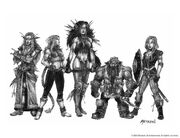
Alliance Races by Chris Metzen[1]. From left to right: High elf, half-elf, night elf, dwarf, and human.
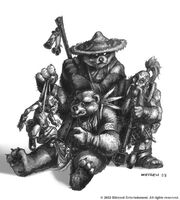
Hero Races by Chris Metzen[2]. Wildhammer dwarf and gnome (Alliance).[4]
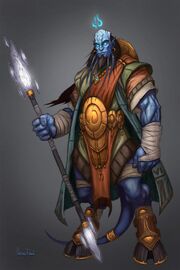
Draenei Male by Glenn Rane
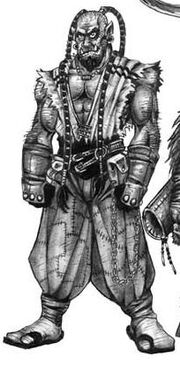
Half-orc
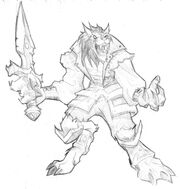
Worgen
The Alliance is not a uniform governmental body, but is a coalition of mutual military and economic aid. Housing the Alliance Assembly, Theramore can be considered the official home of the new Alliance, but both the people and the leadership of Stormwind find it hard to accept. The inability of Stormwind to act forced both Theramore and the night elves to step in, resulting in a growing gap of cooperation between the two continents. Effectively, today's Alliance is in fact two Alliances not only working largely separately but also holding some kind of dislike against each other.[citation needed]
In the past, certain rules, customs, and regulations were a constant hindrance to mutual actions across the entire Alliance. This made cooperation sluggish, and considerably slowed the rate at which the Alliance was able to reclaim its former lands and glory. Despite the problems and intrigues within their leadership, all parts of the Alliance are steadfast in their desire to reclaim and rebuild, and all members share a distrust of the Horde. Approximately 800,000 souls belong to the allied races spanning two continents (based on membership numbers of the Church of Light)[5]. The Alliance is a great and peaceful body overall, their might being legendary, but their desire for peace, even stronger. Above all, where Jaina Proudmoore and Tyrande Whisperwind are good at coordinating their efforts on Kalimdor, Lady Katrana Prestor of Stormwind was doing a fine job of undoing the Alliance in the Eastern Kingdoms,[6] however she has been slain in lore and King Varian Wrynn has now taken his rightful place as king.[7]
Even now, as always, humans are the glue that hold the Alliance together, being the most numerous and diplomatic of the member races. However, the driving force of the Alliance is slowly but steadily shifting to the night elves, who today are a major aspect of the Alliance military forces — whereas the armies of Stormwind keep being held inactive within the city walls.[8] Things may have changed with the return of King Varian Wrynn, if the Stormwind army's presence in Northrend is anything to go by.
The two Alliances
Although no official statements have been drafted, there are essentially two Alliances now, one on Kalimdor and one that operates out of Stormwind Keep on the continent of Azeroth. The alliance citizens in the east consider those who left to have abandoned them. They understand the war with the Burning Legion is over, and that there was a victory; but life is so treacherous with demons, necromancers, undead, warlocks, and rogue Horde bands attacking, it certainly does not feel like there was a victory. If those heroes who won the war were so powerful, why didn't they come home to help drive out the undead and take back their lands?
The newer Alliance, incidentally, is also upset with the older one, as it attacked Durotar without Theramore's approval, and the city was nearly razed because of Admiral Proudmoore's foolhardy actions. Although most in the city agree with the forces who attacked Durotar, they do not appreciate the newcomers goading the orcs into attacking their new home.[9]
Strengths
Technology
- Main article: Alliance technology
Technologically speaking, the Alliance is strong, with gnomish and dwarven inventions.
Heavily armored vehicles with massive guns often help take well-defended structures, or even serve to simply destroy an enemy’s morale. The appearance of three or four armored vehicles can often break an enemy’s morale without ever firing a shot. However, they are well armed in case they do need to fire.
All too frequently, war is the primary driver of technological advancements. The Ironforge dwarves spearheaded this trend, developing gunpowder and firearms as a way to achieve an edge against their foes in combat. Flying machines, originally just curiosities or at best scouting tools, are now being outfitted with flak cannons and bombs. Who knows where these advancements will lead? Technology is the system by which an entire society provides for the wants and needs of its population.
Thus, the dwarves of Ironforge are said to be more technologically advanced than the tauren of Mulgore, who are themselves far more advanced than, say, kobolds or troggs.[10] The Alliance views technology as an extension of a new way of thinking. Humans view technology as a powerful tool, as gnomes and dwarves invent new weapons, devices, and vehicles of war that the humans can benefit from.
Dwarves and gnomes are the true masters of steam and brass; for them, forge and artifice has always been a way of life. The ability to craft magnificent weapons of destruction appeals to the dwarven sense of war, and firearms have become a respected aspect of their culture. Dwarven riflemen are feared, and their steam tank crews are also given tremendous respect for their skill in guiding their magnificent weapons of war.
It is clear to all of the Alliance races that the battlefields are changing thanks to technology. Firearms are a tremendous equalizer, and a trained sniper can be as deadly to a knight as a dragon’s breath. The machines of war provide protection and weapons that level the field even against the mightiest of monsters. That the Alliance is aware of this bodes well for their future.[11] Also, with the inclusion of the draenei into the Alliance, the advanced technology of the draenei is now available.
Tactical mastery
Strategy in combat is the first step toward winning, and the Alliance uses to its fullest. They take advantage of their typical numerical advantage, to overwhelm opposition with shield and sword. They posses great Arcane spell casters which can be seen taking out many troops single-handedly from behind the front line. They have some great shock infantry with the dwarves and draenei, who prove very resilient on the battlefield. The Alliance is also known for its heavy cavalry where mounted human knights and paladins have more than once broken through ranks of Orcs, demons and undead. These mounted warriors have long symbolized the strength of the Alliance armies.
Typically they will utilize flanking tactics, night elven and high elven archery, combined with superior technology and maneuvers to turn battles in their favor allowing heavier troops like human knights and dwarven riflemen to finish their enemies off with the blade and shot. Their commanders are very smart, studying the art of war from a young age, and are able and adept commanders who will utilize their armies to the fullest, on the battlefield.
Holy Magic
Most Alliance races are well-versed in the ways of the holy light, making their paladins and priests formidable opponents. The power of the holy light is also advantageous against the Forsaken as well as other forms of undead due to their extreme weakness against the power with spells such as Exorcism.[12]
Unified
The Alliance has strong unity between its races since its core members have been allied together since the beginning, excluding the night elves and the draenei. The humans, dwarves, high elves, and gnomes have been allies since the Second War and are often tied together. The Alliance has also never truly fallen apart, although there is often disagreements between the Alliance on Kalimdor, led by Jaina Proudmoore and Tyrande Whisperwind, and those traditionally based out of the Eastern Kingdoms, now led by King Varian Wrynn.
Tradition
The Alliance represents older bonds of brotherhood than the Horde, especially between the Humans, Dwarves, High Elves, and Gnomes. And while the Draenei are new to Azeroth, the other races retain ancient holdings. This stands in stark contrast to the Horde, all of whom, with the exception of the Blood Elves, have undergone significant migrations in the past decade. This gives the Alliance more established infrastructure and generally more territorial control, if not a higher level of dedication - Orgrimmar and Thunder Bluff, and the Forsaken squatting in Lordaeron's sewers and ruins, stand in stark contrast to the strong walls of Stormwind and Ironforge.
Weaknesses
Although the Alliance has built an impressive army in the past years, finding strength in its diversity and numbers, weak points still exist that the Alliance’s enemies can take advantage of when fighting. For example, some lackluster commanders exist within the ranks. Though through this they still maintain a very impressive army.[13]
Pride
The Alliance is proud of itself. Their people are sophisticated and learned, and they excel in the intellectual pursuits such as arcane magic and engineering. Even after three bloody wars, they still view themselves as overall smarter than the Horde, and believe that greater brain power wins out over primal force. This is even after they fought alongside the Horde in the Third War and saw how they had changed. They underestimate the Horde, especially the new Horde under Thrall, and could easily be guilty of underestimating their enemies’ abilities.[13]
Arcane Magic
- Main article: Alliance magic
Though their powerful command of the arcane is a point of strength in the Alliance’s arsenal, it also shows a weakness. The magi are weak and easy to kill, if an enemy can break through their protections.[13] The benefits of these spellslingers in combat are very rich, causing destruction from a distance unchecked by the enemy.
Physical strength
The front lines of the Alliance’s armies are always in danger against the physically stronger Horde, especially the orcs and tauren.[13] Draenei are stronger then most of Alliance races, but not as strong as orcs or tauren. Only the arrival of Worgen in Cataclysm will probably add a brute force to Alliance.
Territory
Though the Alliance has a vast amount of territory, its distribution is almost one sided, most of the Alliance territory is in the Eastern Kingdoms. The Alliance presence in Kalimdor is weak, confined mainly to Teldrassil, the islands of Azuremyst and Bloodmyst, and Darkshore (the only mainland Alliance territory in Kalimdor). Though they have also made a strong establishment in Dustmallow Marsh on Theramore Isle. It should be noted that there is a rapidly growing revanchist movement among the Alliance ranks, fueled increasingly now that Varian Wrynn has returned to Stormwind; should the Horde attempt to overwhelm any of the vulnerable Alliance holdings, then it would likely spark all out war, and thus this weakness would prove to be a strengh.
References
- ^ Alliance Player's Guide, 167
- ^ World of Warcraft manual, p.171
- ^ "Beginnings and Ends"
- ^ The gnomes and Wildhammer dwarves are members of the Alliance. The furbolgs and pandarens are Independent though friendly to the Alliance.
- ^ Alliance Player's Guide, ???
- ^ Alliance Player's Guide, 163
- ^ World of Warcraft: Issue 14
- ^ Alliance Player's Guide, 163-166
- ^ World of Warcraft: The Roleplaying Game, 12
- ^ Alliance Player's Guide, 100, 181
- ^ More Magic and Mayhem, 164
- ^ World Of Warcraft: Paladin Spells
- ^ a b c d Alliance Player's Guide, 182
| |||||||||||||||||||||||||||||
| ||||||||||||||||||||||||||||||
| ||||||||||||||||||||||||||||||||||||||||||||||||||||||||||||||||||||
da:Alliance




